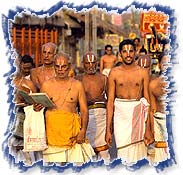Tamil Nadu is bounded by Karnataka and Andhra Pradesh in the north and
Kerala in the west. The eastern and western tips of the Tamilnadu are
defined by the Point Calimere and Mudumalai wildlife sanctuaries while the
northern extreme is Pulicat lake and the southernmost tip is Kanyakumari,
the land's end. Tamil Nadu is principally washed by the Cauvery, originating
in Coorg in neighbouring Karnataka . Chennai, the capital of Tamil Nadu is
known for its beautiful beach resorts.
Tamil Nadu - A Temple State
Tamil Nadu, the cradle of south Indian temple architecture, is a living
museum of styles that originated in the 7th century and matured in the huge
temple complexes studded with towering gateways-"Gopurams"-that
soar above the markets of almost every town. Mahabalipuram, Kanchipuram,
Chidambaram, Kumbakonam, Rameswaram, Palani, Srirangam, Tiruttani and
Kanyakumari are some of the famous pilgrim centres in Tamil Nadu. The famous
Meenakshi
temple of Madurai is a must see.
The Nilgiri Panorama
In the west of the state, where the hill stations of Kodaikanal and Ooty
are the premier travel attractions, sylvan hills offer mountain views and a
network of trails winds through forests and tea and coffee plantations.
Mudumalai Wildlife Sanctuary, a vast spread of deciduous forest in Tamilnadu
dominated by teak, offers a good chance of spotting elephants and dholes,
wild pack-hunting Dogs, Tigers and Leopards.
Annamalai Sanctuary in Tamil Nadu, closer to Kodaikanal in the Palani
hills, is better known for its Lion-tailed Macaques (black-maned Monkeys).
The wetlands of the coast provide perfect resting places for migratory
birds, whose numbers soar during the winter monsoon at Vedathangal, near
Chennai, and Point Calimere.
 History of Tamilnadu
History of Tamilnadu
Tamil Nadu was ruled by three major dynasties-the Cholas in the east, the
Pandyas in the central area and Cheras in the west. This was during the
Sangam Age-the classical period of Tamil literature-that continued for some
300 years after the birth of Christ. The Pallava dynasty was influential
particularly in the 7th and 8th centuries, the testimonies to which are the
monuments at Mamallapuram.
In the 13th century, with threats of Muslim invasions from the north, the
southern Hindu dynasties combined and the empire of Vijaynagar (also spelt
as Vijayanagar), which covered all of South India, became firmly
established. However, by the 17th century, due to the disintegration of the
Vijaynagar Empire, various small rulers like the Nayaks ruled southern
India.
By the middle of the 18th century, there were frequent conflicts between
the British, French, Danes, and Dutch due to their interest in these areas.
The British were finally victorious, while small pocketed areas including
Pondicherry and Karaikal remained under French control. Under the British
rule, most of south India was integrated into the region called the Madras
Presidency. In 1956, the Madras Presidency was disbanded and Tamil Nadu was
established.
An Agro-Based Land - Tamilnadu
Although Tamil Nadu is one of the most urbanized states of India, it is
still a rural land; agriculture is the mainstay of life for about
three-quarters of the rural population. The principal food crops are rice,
maize, Jowar, Bajra, Ragi, and pulses. The cash crops include cotton,
sugarcane, oilseeds, coffee, tea rubber, and chillies.
The major industries of Tamil Nadu include cotton textiles, chemicals,
fertilizers, paper and paper products, printing and allied industries,
diesel engines, automobiles and parts, cement, sugar, iron and steel, and
railway wagon and coaches. The state of Tamilnadu is the largest textiles
producer in India and an important exporter of leather and leather products,
cotton piece goods, tea, coffee, spices, tobacco, etc.
There are a number of hydel power stations in Tamil Nadu. The atomic power
plant is located at Kalpakkam, in the Chengalpattu MGR district.
Tamil Nadu is rich in handicrafts; notable among them are hand loomed silk,
metal icons, leather work, Kalamkari (hand-painted fabric, using natural
dyes), brass, bronze, and copper wares, and carved wood, palm leaf, and cane
articles. For the best Chola bronzes and a glimpse of the magnificent
paintings that flourished under Maratha rajas in the 18th century,
travellers should head for Thanjavur.
Capital of Tamilnadu

Chennai
(formerly, Madras), the largest city in South India and the fourth largest
city in the country, is located on the Coromandel Coast. The city's British
lineage is evident in the various cathedrals, buildings in Indo-Saracenic
style of architecture, wide tree lined avenues but there is no denying its
traditional Tamil Hindu culture either. This is not surprising because this
region had remained a centre of Pallavan culture long before the British
came here.
The varied aspects of traditional South Indian culture existing alongside
the lifestyle of a modern city complete with its plush hotels, restaurants
offering a range of continental to typical South Indian cuisine, long and
uncrowded stretches of beaches, modern shopping malls, cinema halls, etc.
The People
Tamil, the official state language, is spoken by most of the people. The
main religions in Tamil Nadu are Hinduism, Christianity, Islam, and Jainism.
There is an established caste system, and the traditional differentiations
here are a lot more pronounced than in many other parts of the country. The
Brahmin community in Tamilnadu is very pious and people normally have a
white mark on the forehead to signify caste.
Performing Arts in Tamil Nadu
Tamil Nadu is synonymous with the Indian musical maestro of the 18th
century, Thyagaraja. The land of Carnatic music, Tamil Nadu, is the
birthplace of many other music legends as well. The main instruments used
are the Violin, Wooden flute, 'Veena', 'Gottuvadayam', 'Mridangam' (also
spelt as Mridanga), 'Nadaswaram' and 'Ghatam'.
Bharatanatyam, one of India's major classical dance forms, and Carnatic
music are both widely practiced. Painting and sculpture, however, are less
developed, although there are schools that teach the art of sculpture in
stone and bronze. Tamil literature rapidly adapted to the Western literary
forms of the novel and the short story. Since the 1940s, cinema has become
the most popular form of mass entertainment. There are both touring and
permanent cinema theatres; and sentimental and spectacular films, often
featuring light music and dancing, are produced by the film studios situated
largely around Chennai.
Festivals of Tamilnadu

The
main festival of Tamilnadu is Pongal, which is a harvest festival celebrated
in the month of January. Feasting, music and dance mark this festival. "Karthigai
Deepam" and "Varushapirapu" (Tamil New Year's Day) are also
celebrated on a grand scale.
Several temple festivals are held throughout the Tamilnadu, of which The
Mahamagam festival celebrated once in 12 years at Kumbakonam, Meenakshi
Kalyanam festival at Madurai, Natyanjali Dance Festival at Chidambaram are
the famous ones.
Climate of Tamilnadu
The climate of Tamil Nadu is essentially tropical. The temperature in
summer seldom 43º C and in winter seldom falls below 18º C. The
lowest temperatures are recorded during December and January, and the
highest in April to June. The average annual rainfall, falling mainly
between October and December, ranges between 25 and 75 inches. The most
precipitation falls in the Nilgiris and other hill areas.
Population of Tamilnadu : 55,638,318


 History of Tamilnadu
History of Tamilnadu Chennai
(formerly, Madras), the largest city in South India and the fourth largest
city in the country, is located on the Coromandel Coast. The city's British
lineage is evident in the various cathedrals, buildings in Indo-Saracenic
style of architecture, wide tree lined avenues but there is no denying its
traditional Tamil Hindu culture either. This is not surprising because this
region had remained a centre of Pallavan culture long before the British
came here.
Chennai
(formerly, Madras), the largest city in South India and the fourth largest
city in the country, is located on the Coromandel Coast. The city's British
lineage is evident in the various cathedrals, buildings in Indo-Saracenic
style of architecture, wide tree lined avenues but there is no denying its
traditional Tamil Hindu culture either. This is not surprising because this
region had remained a centre of Pallavan culture long before the British
came here.  The
main festival of Tamilnadu is Pongal, which is a harvest festival celebrated
in the month of January. Feasting, music and dance mark this festival. "Karthigai
Deepam" and "Varushapirapu" (Tamil New Year's Day) are also
celebrated on a grand scale.
The
main festival of Tamilnadu is Pongal, which is a harvest festival celebrated
in the month of January. Feasting, music and dance mark this festival. "Karthigai
Deepam" and "Varushapirapu" (Tamil New Year's Day) are also
celebrated on a grand scale. 